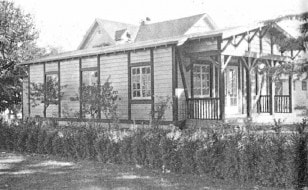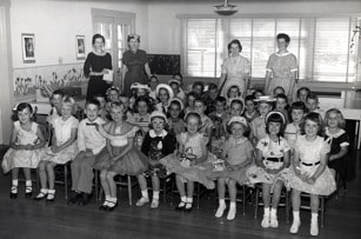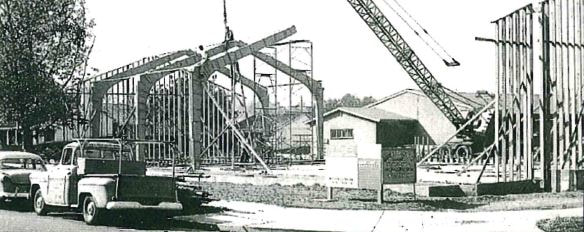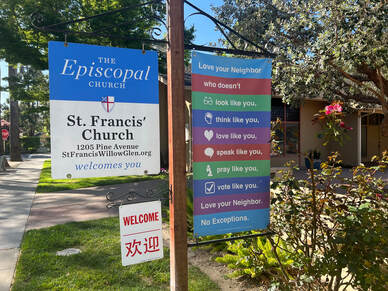The History of St. Francis Episcopal Church
For many of us, St. Francis Episcopal Church has become our spiritual home. Some of us were born and raised in the Valley of Heart’s Delight, while many of us have come to San Jose to harvest the fruits of Silicon Valley. Young and old, we are one family in Christ, and like generations before us, we gather at 1205 Pine Avenue to nurture our spirits and community.
 1139 Minnesota circa 1927
1139 Minnesota circa 1927
In The Beginning
As Willow Glen blossomed into a thriving bedroom community in the early 1900’s, the need for an Episcopal Church became evident. Trinity Cathedral in downtown San Jose was becoming overcrowded, and young families in Willow Glen needed their own local parish and church school. So in 1927, Trinity Cathedral funded the remodeling of a butcher's shop at 1139 Minnesota Avenue to serve as a Trinity church school in Willow Glen. G. Arthur Abbinette, a vestryman at Trinity Church who resided in the Willow Glen area, was placed in charge as a superintendent and guided its destinies for more than ten years.
As Willow Glen blossomed into a thriving bedroom community in the early 1900’s, the need for an Episcopal Church became evident. Trinity Cathedral in downtown San Jose was becoming overcrowded, and young families in Willow Glen needed their own local parish and church school. So in 1927, Trinity Cathedral funded the remodeling of a butcher's shop at 1139 Minnesota Avenue to serve as a Trinity church school in Willow Glen. G. Arthur Abbinette, a vestryman at Trinity Church who resided in the Willow Glen area, was placed in charge as a superintendent and guided its destinies for more than ten years.
|
A chancel was prepared and the altar (from the Episcopal Mission Property in Santa Clara) was placed in the Minnesota Avenue chapel where the first communion service was held on the third Sunday in September 1941.
Soon this little church school also became overcrowded with eager church school children. In an effort to keep pace, Trinity remodeled the ex-butcher's shop three more times before it was finally determined in 1945 that the property could no longer sustain the growing church school community. |
Francis and Frances
Meanwhile, a group of church school mothers began meeting in 1941 to assist Trinity in the fundraising required for the remodels. They named themselves The Saint Francis Circle, in part to honor their dear friend and educator Frances Shallenberger. "Aunt Fan," as she was affectionately known, was a retired school teacher who provided much of the enthusiasm and experience required to grow the church school.
In 1945, the vestry at Trinity, ever supportive of the growing community of the Willow Glen branch, purchased additional property across from 1139 Minnesota on Iris Court to provide more classrooms and to serve as a parish house. Yet it quickly became apparent that even this new space was inadequate. Neighborhood homes rented out rooms to accommodate the overflow of students.
Meanwhile, a group of church school mothers began meeting in 1941 to assist Trinity in the fundraising required for the remodels. They named themselves The Saint Francis Circle, in part to honor their dear friend and educator Frances Shallenberger. "Aunt Fan," as she was affectionately known, was a retired school teacher who provided much of the enthusiasm and experience required to grow the church school.
In 1945, the vestry at Trinity, ever supportive of the growing community of the Willow Glen branch, purchased additional property across from 1139 Minnesota on Iris Court to provide more classrooms and to serve as a parish house. Yet it quickly became apparent that even this new space was inadequate. Neighborhood homes rented out rooms to accommodate the overflow of students.
|
In 1946, with help from the Saint Francis Circle and Trinity Church, larger property was sought, which led to the purchase of a large home and adjacent lots on the corner of Pine and Newport with plans to finally build a chapel for worship.
In the early Fall of 1947, church school classes began in the large Pine Avenue home. Worship services continued to be held at the chapel on Minnesota Avenue until the following Fall. In September 1948 the twenty-one-year-old butcher shop-cum-church school on Minnesota Avenue was sold, and the last services there were held on October 3. The house at 1205 Pine Avenue was readied, the reed organ installed, and the first church services at the new location were held the following Sunday, October 10, 1948. |
|
The past year and a half were dedicated to establishing this Willow Glen mission of Trinity as an independent, self-sustaining parish. On December 31, 1948, the mission and school officially launched as an incorporated parish and became Saint Francis Episcopal Church (Willow Glen) of the Diocese of California.
Now as a formal parish, the first annual meeting took place on Tuesday evening, January 4, 1949. The rector's report for 1948 showed 213 communicants on the parish roll. Other activities during the year included 38 baptisms, 58 confirmations, 25 funerals, and 5 weddings. With such an active and growing parish, the congregation approved building plans, as outlined by the vestry, to build a chapel at the northeast corner of the property. |
|
The First Chapel
Just six months later, in June of 1949, the Frances Schallenberger Memorial Chapel opened. It was dedicated by her sister, Dr. Margaret McNaught, who was also a well-regarded educator. |
Chapel Extension
In 1951, St. Francis was thriving and plans were underway for an expansion beyond the chapel to include office space for the rector and church secretary, a choir room, rest rooms, eight small classrooms, and a large primary or kindergarten room.
In 1951, St. Francis was thriving and plans were underway for an expansion beyond the chapel to include office space for the rector and church secretary, a choir room, rest rooms, eight small classrooms, and a large primary or kindergarten room.
Parish Hall Addition
1951 also saw the death of Dr. McNaught at the age of 89. She generously left much of her estate to St. Francis. These funds covered the expansion costs and provided the foundation for a much-needed parish hall. The expansion was opened in January of 1953, and the hall was opened and dedicated to her memory on October 31, 1954.
1951 also saw the death of Dr. McNaught at the age of 89. She generously left much of her estate to St. Francis. These funds covered the expansion costs and provided the foundation for a much-needed parish hall. The expansion was opened in January of 1953, and the hall was opened and dedicated to her memory on October 31, 1954.
A brief lull now took place as the parish adjusted to its new facilities. The church school was well taken care of, but church services in the chapel were crowded and overflowed into the parish hall. The decision was then made to complete the original building plan with the ambitious construction of a spacious, modern church sanctuary.
|
The Main Church
The vestry engaged a professional fund raising firm in February 1956 and by May a campaign was under way resulting in more than $122,000 pledged by the congregation to be paid over a three-year period. Groundbreaking ceremonies for the new church were held June 1, 1957. Presiding were: left to right, The Rev. Stuart Anderson, Bishop Karl Morgan Block, and The Rev. F. Marshall Wickham, Rector of St. Francis. Work began with the demolition of the old parish house on the front of the property and the excavation for the basement. |
|
Sunday Service Times
The Holy Eucharist, 8:00 a.m. & 10:15 a.m. in-person and 10:15 a.m. livestream |
















